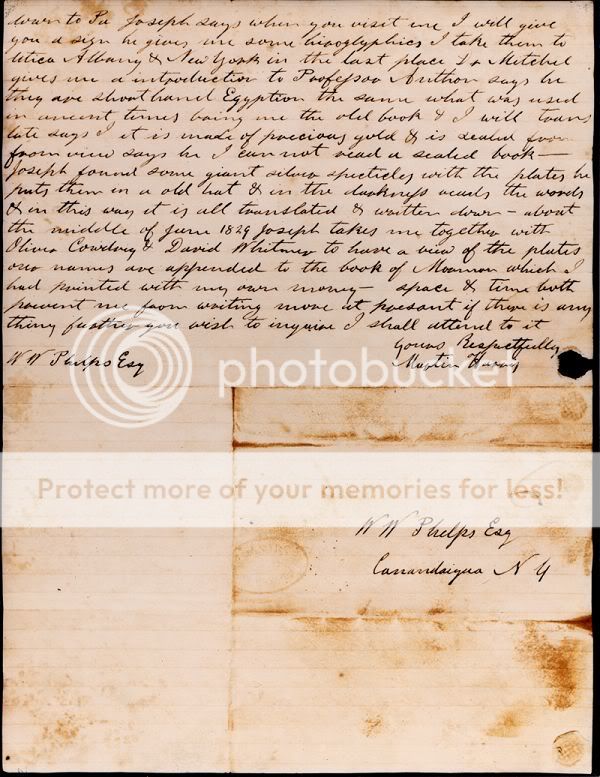Ripples from a Salamander: 24 Years Later
Mourning for the loss of bomb victims Kathy Sheets and Steve Christensen (along with the aforementioned reverberations of fear) weren’t the only aftershocks from Hofmann’s strange attempt to make a fortune by casting doubt on the religion he no longer believed in. I was only three years old when the forgeries were exposed and Hofmann’s efforts went up in smoke. Once in a while I catch a slight whiff of burning amphibian while reading or researching Mormon history. Hearing about the experience of those who dealt with the letter in real time has helped me better understand how the letter still reverberates today.
First, the Salamander letter was another catalyst for Mormon historians to better evaluate the environment and culture of early Mormonism and the restoration of the gospel. Richard Bushman, Ronald Walker, Dean C. Jessee and other historians began plumbing the environmental influences with research questions that have spurred even richer historical treatments with more to come.2 Other researchers began (or continued) fashioning more naturalistic explanations for Joseph Smith’s claims. Marvin Hill, John Brooke, D. Michael Quinn and others have produced scholarship that carries hints of the salamander (and in some ways, the salamander originally carried a hint of what was already being discussed by certain scholars).3
Second, the Salamander letter is a reminder that prophets and leaders of the Church are not infallible and all-knowing. President Hinckley’s public statements when the letter was made known to the public make it clear he was not entirely convinced of the document’s authenticity, but for the time being accepted the judgment of certain document and history experts. Joseph Smith received a revelation reminding him that a prophet is not granted to know all the designs of people who seek to destroy the Church:
But as you cannot always judge the righteous, or as you cannot always tell the wicked from the righteous, therefore I say unto you, hold your peace until I shall see fit to make all things known unto the world concerning the matter (D&C 10:37).4Third, the Salamander letter reminds current historians to take care in the use of historical sources. In some instances, this is more hindrance than help. Researcher Ardis Parshall noted that she has to be wary of using any document that passed through Hofmann’s hands. For instance, while researching information on the Utah War she located the diary of one observer containing many interesting details that will have to be substantiated elsewhere because Hofmann possessed it at one point. She notes that the Church archive catalog is very good about noting the Hofmann connection on every record involved.5
Finally, the Salamander letter provides examples of how faithful members of the Church confronted difficult information. Consider Kevin Barney’s reaction:
The salamander letter is the only thing I ever recall encountering that gave my testimony a pretty good shake. Lots of people today say they thought it was a forgery even then, but at the time mainstream historians pretty much all thought it was authentic. I thought it was authentic.FAIR volunteer McKay V. Jones explained how Kevin’s experience reminder her of her “fly ball” analogy:
But here’s a good lesson in what to do when you get rattled by something. Instead of rolling over and playing dead and giving up, I rolled up my sleeves and went to the library. I studied non-LDS historical articles on folk magic, having nothing to do with Mormonism. These articles were focused on an earlier period–17th century, as I recall–but there was a clear continuity with what was going on in backwoods upstate New York in the early 19th century. Once I had an historical context in which to understand these events, my concerns quickly melted away. I would have been fine even if the letter proved to be genuine. I haven’t been bothered by folk magic stuff since. So for me this exposure was actually a good thing in the long run.
I was Gospel Doctrine teacher in my Ward at the time and I devoted an entire lesson to the letter. It was an awesome lesson, and that experience is a large part of the reason I’m an advocate of inoculation. Because I knew how dangerous that material was, since it had even rattled me, yet at the end of that lesson I also knew that no one who sat in that room was going to lose faith over it. That realization made a powerful impression on me.6
When I was young, I had a problem mis-judging fly balls. I would instinctively run in on them, and when they were over my head, I would have to back-pedal or run back on them. It is much harder to catch a fly ball running back on it than running in on it. I learned to have my first step be *back*, even when it looked like it would be short. You can always run in on it if you misjudged it, but if you run in on it and have to go back on it, it’s a much more difficult catch.
With difficulties that throw us for a loop, we need to “step back” and study the issue in a way similar to what Kevin described. As Davis Bitton said in his “I don’t have a testimony of the history of the Church” talk, when one assesses in advance what the “worst case scenario” and “best case scenario” would be, the “worst case” is never remotely approached, and usually the “truth” is found to be somewhere between the two extremes. Managing expectations and “best & worst case” findings works wonders towards preventing shipwreck.7These are just a few ripples in the water extending from the original explosion of document and gunpowder. In the face of future explosions it is wise to remember the patience exhibited by researchers whose efforts were borne out when the forgeries were exposed. Instead of rolling over and playing dead and giving up, we can roll up our sleeves and go to the library.
_____________________________________________________
For a full transcript, images of the letter, and other links see BHodges, “Mark Hofmann and the Salamander Letter,” LifeOnGoldPlates.com, 15 October 2009. Photograph by Alex Monro, from "3 New Salamanders Are 'Ballistic,' Bright, Tiny," NationalGeographic.com, 4 January 2008. This post is cross-posted from fairblog.org.
[2]
BYU Studies Volume 24:4 (Fall 1984) contains interesting contemporaneous responses to the Salamander letter. See especially Ronald W. Walker, “Joseph Smith The Palmyra Seer.” Small elements of influence can be seen from Mark Ashurst-McGee’s work on seer stones and treasure guardians to Richard Bushman’s Smith biography Rough Stone Rolling and many works in-between.
[3]
Perhaps two of the more obvious examples of works with “salamander-shaped holes” (to borrow a phrase from Stephen E. Robinson) are D. Michael Quinn’s Early Mormonism and the Magic World View (revised and enlarged edition, Salt Lake City: Signature Books, 1998), and Grant Palmer’s Insider’s View of Mormon Origins (Salt Lake City: Signature Books, 2002).
[4]
See the FAIRwiki article, “Church reaction to forgeries.”
[5]
Ardis Parshall (of the “Keep-a-Pitchin’-In” blog), personal e-mail, 16 October 2009. First edition copies of Dean C. Jessee’s Personal Writings of Joseph Smith (Shadow Mountain, 1984) included several not-then-debunked Hofmann forgeries. The younger, better looking edition (2002) omits them. D. Michael Quinn’s first edition of The Mormon Hierarchy: Origins of Power (Signature Books, 1994) erroneously references a Hofmann forgery though they had been debunked for several years. The mistake was corrected for the 1997 printed edition. See the FAIRwiki article “Nauvoo Legion to rescue Joseph.”
[6]
Kevin Barney, personal e-mail, 16 October 2009.
[7]
Suzie McKay, personal e-mail, 16 October 2009. See Davis Bitton, “I Don’t Have a Testimony of the History of the Church,” 2004 FAIR Conference presentation.




 3
Comments
3
Comments


